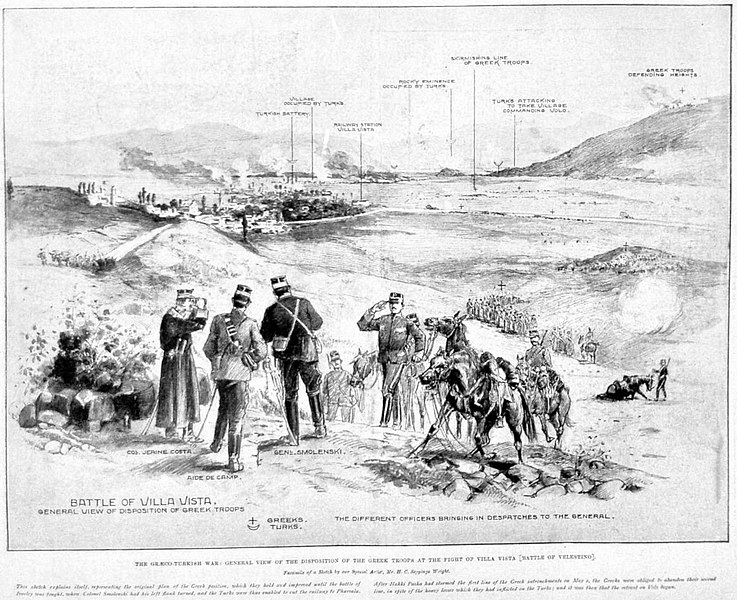İzzet Paşa for the first time started to relate his personal
role in the Thessaly battles of Spring 1897.//

At this point in his lecture, Ahmed İzzet Paşa
explained the situation after the battle at
Melouna (Milona) in mid-April.
The only ones who handled this retreat calmly were those in the
Smolensky detachment. Even though we launched a serious pursuit
operation, and although it would have been possible to separate the
Makri division, the Smolensky detachment and the Mavru Mihali
division, their hasty retreat was enabled by our slowness in pursuit.
Our calvary did not conduct reconnaissance and there were hesitations
in our decision-making, both of which hampered our pursuit. The Greek
Army didn't retreat in fear and chaos but, rather, in a disorderly manner.
Subsequently, Grombikov Paşa went with a cavalry unit and occupied
Yenişehir (Larissa). On that same day, under the leadership of Ali Rıza,
now the Minister of War (at this juncture, Ahmed İzzet Paşa pointed to
Ali Rıza, who was attending his lecture), we five officers - Col.
Mahmud, Major İzzet Bey, Adjutant Major Mehmed Ali, and Captains
Rıza and Nuri Efendi- arrived at Alasonya (Elassona).
We could not understand the battlefield situation on our left. The
army's staff officer had gone ahead. That evening, the Austrian military
attaché brought us the translation of a telegram he had sent to Vienna in
German. From this telegram were able to understand the status of our
forces, as follows:
6th Division assembled at Kozköy
5th Division at Yenişehir (Larissa)
2nd Division at Tarnuh
4th Division at Mati and Milona (Melouna)
1st Division at Çayhisar
3rd Division at Yenişehir (Larissa)
1 reserve brigade at Alasonya (Elassona)
The battlefield as of 18 April 1897. Yenişehir
(Larissa) is the city at bottom right. Turkish
forces were concentrated at Alasonya (Elissona),
upper left.
There was no information at all about the enemy. Contact had been
completely lost. Consequently, we devised a deployment plan, such
that our main force would assemble between Yenişehir and Tarnuh;
troops would be sent, with some cavalry, to Zark for reconnaissance
and defense of our right, and to reinforce the 1st Division; although
there was a proposal made to split the cavalry division in two and send
one portion to Çatalca (Pharsalos) and the other to Golos (Volo) for
reconnaissance, this proposal was not approved. And yet, in light of
the enemy's paucity of cavalry, there would have been no great harm
in separating our cavalry in this way.
The following day, we were sent to Çayhisar to join in the operations
of the 1st Division, which was being sent to Zark. On 16 April, we
understood that a division would be sent to establish an army HQS
in Yenişehir, two divisions would move in front of Yenişehir, Neşat
Paşa's division would be brought to Tarnuh and a cavalry brigade
and an infantry regiment would head in the direction of Velestino.
This arrangement reflected a small change in our proposal. The
advance of the 1st Division to Tirakki (Tırhala) was, in fact, excessive
and not a sensible decision.
The force sent toward Velestino came in contact with the enemy and
asked for assistance. Consequently, this force was reinforced with an
infantry regiment and Col. Mahmud Muhtar, who had recently arrived
at the operations HQS (he is now the commander of the Hassa Army
- Imperial Guard Regiments) joined this detachment. Under the
direction of the aforenamed individual, an attack was launched on
Velestino on 18 April. Since I did not personally participate in this
battle, I cannot provide any details. But this much I can say - the
attack on Velestino was an example of courage and honor.
Since Smolensky had fortified the Velestino outskirts, considered
to be his flank, and added more troops there, our attack cannot be
characterized as a success. Consequently, Hakkı Paşa reinforced the
troops there with 3 infantry regiments. But since there was no longer
a need for excessive cavalry, the cavalry brigade was pulled back to
the division.
Velestino (red star)
I think it was 18 April when an order came from Istanbul officially
assigning our group to the general staff. So we reorganized the general
staff into three offices: the first was the intelligence office under Col.
Sabit Bey; the second being the military operations office, where I
was; and the third office dealt with provisioning and support issues. In
a sense, the army's war organization had been re-formed and re-
assembled.
Since it was, of course, the mandate of this newly established HQS to
acquire information about the enemy, we ordered an officer from the
general staff to accompany the commander of the cavalry division
and tasked him with ensuring that information be obtained about
the enemy's situation at Çatalca (Pharsalos). Unfortunately, this did
not happen.

View of the Battle of Velestino from the Greek perspective.
//END OF PART V//
//END OF PART V//


Hiç yorum yok:
Yorum Gönder